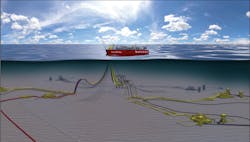Environmental issues to shape future offshore Asia/Pacific projects
Offshore staff
SINGAPORE – Wood Mackenzie expects an upsurge in major oil and gas project sanctions in the Asia/Pacific region this year.
New developments incurring $35 billion of expenditure cold go forward to produce 4.6 Bboe, compared to just $5.5 billion and 1.2 Bboe in 2019.
Wood Mackenzie senior analyst David Low said that offshore Australia, “Barossa is closest to the line as new operator Santos looks to backfill the Darwin LNG plant.
“We expect Woodside to sanction Scarborough to underpin the Pluto Train 2 expansion, and Shell is set to take FID on the Crux field to backfill the Prelude FLNG facility.”
Research director Andrew Harwood added: “In Q1 2020, Petronas will be looking to develop its deepwater expertise close to home through Limbayong, offshore Sabah, and the Kelidang Cluster, offshore Brunei.”
Last year did deliver a record level of exploration across Asia/Pacific, Wood Mackenzie acknowledged. Now the process is under way of delineating some of 2019’s key discoveries.
Appraisal drilling at Repsol’s Kali Berau Dalam, Eni’s Ken Bau, PTTEP’s Lang Lebah, and CNOOC’s Yongle 8-3 fields will need to confirm commerciality ahead of development planning.
This year’s potential play-openers could be in New Zealand’s Great South basin, deepwater Myanmar, offshore North Sumatra, and offshore Papua.
Harwood said: “In 2020, we expect a growing focus on improving recovery rates by NOCs and smaller specialist players.
“Pertamina [in Indonesia] will hope to slow declines at Offshore Mahakam via an ambitious drilling campaign and new well and platform designs.
“PTTEP [in Thailand] aims to recover more contingent resources from G1/61 (Erawan) and to lower development costs through synergies with its nearby assets.”
As for divestments of mature assets, Chevron’s Indonesia Deepwater Development and Repsol’s PM3 CAA could both change hands over the next 12 months, the consultant claimed.
More could follow as IOCs seek to scale back on carbon-intensive assets. Offshore projects that do go-ahead may also place more emphasis on carbon capture during development, and in some cases, the use of renewables to power upstream operations.
Harwood said: “Petronas’ 7 tcf Kasawari gas field offshore Sarawak is one of the flagship projects to watch.
“Sanctioned in 2019, we foresee Petronas abandoning previous plans to vent the field’s 20%+ CO2 [carbon-dioxide], in favor of a more ambitious capture and sequestration solution.”
01/09/2020
